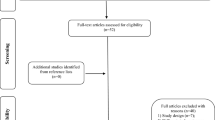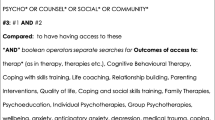Abstract
The aim of our study was to provide a psychosocial and psychiatric evaluation of patients with epidermolysis bullosa (EB; a rare genetic disorder characterized by skin fragility), to assess psychological status, ascertain the presence of any psychiatric disorders and understand the impact of EB on quality of life. Twenty-five patients were assessed using a case record form and several standardized instruments. In 82% of patients, EB had a negative impact on quality of life and 80% of patients experienced psychiatric symptoms. Our findings revealed a high prevalence of psychosocial problems and psychiatric symptoms in patients with EB and suggested that a combined bio-psychosocial approach is the most appropriate therapeutic intervention.
Similar content being viewed by others
References
Achenbach, T. M. (1991). Manual for the Child Behavior Checklist/4–18 and 1991 Profile. Burlington, VT: University of Vermont.
Achenbach, T. M., & Edelbrock, C. (1983). Manual for the Child Behavior Checklist and Revised Child Behavior Profile. Burlington, VT: Queen City Printers.
Achenbach, T. M., & Rescorla, L. A. (2000). Manual for ASEBA preschool forms and profiles. Burlington, VT: University of Vermont, Research Center for Children, Youth, and Families.
Achenbach, T. M., & Rescorla, L. A. (2004). Achenbach System of Empirically Based Assessment (ASEBA). (Version 5.0) [computer software]. Burlington, VT: Assessment Data Manager (ADM).
Ambrosini, P. J. (2000). Historical development and present status of the Schedule for Affective Disorders and Schizophrenia for school-age children. Journal of American Academy Child Adolescent Psychiatry, 39, 1.
Andreoli, E., Mozzetta, A., Angelo, C., Paradisi, M., & Foglio Bonda, P. G. (2002). Epidermolysis bullosa, psychological and psychosocial aspects. Dermatology and Psychosomatics, 3, 77–81.
Clark, A., & Friedman, M. J. (1983). Psychometric evaluation of the Symptom Checklist (SCL-90) in psychiatric inpatients. Personality and Individual Differences, 14, 751–759.
Derogatis, L. R. (1983). SCL90: Administration, scoring and procedures manual for the revised version. Baltimore: Clinical Psychometric Research.
Derogatis, L. R. (2005). ARC90. Gestione e archiviazione del test sintomatologico Symptom Check List 90 (SCL-90) (Version 1.2.1) [computer software]. Siracusa: Cryteria Technologies.
Derogatis, L. R., & Melisaratos, N. (1983). The Brief Symptom Inventory: An introductory report. Psychological Medicine, 13, 595–605.
Engelhardt, U., Kuster, W., Stangier, U., & Gieler, U. (1997). Krankheitsbewaltigung bei Patienten mit Epidermolysis bullosa hereditaria. Zeitschrift fur Hautkrankleiten, 72, 651–656.
Fine, J. D., Eady, R. A. J., Bauer, E. A., Bauer, J. W., Bruckner-Tuderman, L., Heagerty, A., et al. (2008). The classification of inherited epidermolysis bullosa (EB): Report of the third international consensus meeting on diagnosis and classification of EB. Journal American Academy Dermatology, 58, 931–950.
Fine, J. D., Johnson, L. B., Weiner, M., & Suchindran, C. (2005). Impact of inherited epidermolysis bullosa on parental interpersonal relationships, marital status and family size. British Journal of Dermatology, 152, 1009–1014.
Finlay, A. Y., & Khan, G. K. (1994). Dermatology Life Quality Index (DLQI): A simple practical measure for routine clinical use. Clinical and Experimental Dermatology, 19, 210–216.
Horn, H. M., Priestley, G. C., Eady, R. A., & Tidman, M. J. (1997). The prevalence of epidermolysis bullosa in Scotland. British Journal of Dermatology, 136, 560–564.
Horn, H. M., & Tidman, J. (2002). Quality of life in epidermolysis bullosa. Clinical And Experimental Dermatology, 27, 707–710.
Kaufman, J., Birmaher, B., Brent, D., Rao, U., Flynn, C., Moreci, P., et al. (1997). K Schedule for Affective Disorders and Schizophrenia for School-Age Children-Present and Lifetime Version (K-SADS-PL): Initial reliability and validity data. Journal of American Academy of Child and Adolescent Psychiatry, 36, 980–988.
Kaufman, J., Birmaher, B., Rao, U., & Ryan, N. (2004). Test K-SADS-PL. Trento: Erikson.
Lai-Cheong, J. E., Tanaka, A., Hawche, G., Emanuel, P., Maari, C., Taskesen, M., et al. (2009). Kindler syndrome: A focal adhesion genodermatosis. British Journal of Dermatology, 160, 233–242.
Magliano, L., Guarnieri, M., Marasco, G., Veltro, F., & Morosini, P. (1993). Studio di riproducibilità di un’intervista semi-strutturata per l’accertamento della disabilità sociale e del carico familiare (A.D.C.). Napoli: Idelson.
Pfendner, E., Uitto, J., & Fine, J. D. (2001). Epidermolysis bullosa carrier frequencies in the US population. Journal of Investigative Dermatolology, 116, 483–484.
Tabolli, S., Sampogna, F., Di Pietro, C., Paradisi, A., Uras, C., Zotti, P., et al. (2009). Quality of life in patients with epidermolysis bullosa. British Journal of Dermatology, 161, 869–877.
Tadini, G., Gualandri, L., Colombi, M., Paradisi, M., Angelo, C., Zambruno, et al. (2005). Original articles. Giornale Italiano di Dermatologia e Venereologia, 4, 359.
Valtolina, G. G. (2000). Famiglia e disabilità. Milano: Franco Angeli.
van Scheppingen, C., Lettinga, A. T., Duipmans, J. C., Maathuis, C. G. B., & Jonkman, M. F. (2008). Main problems experienced by children with epidermolysis bullosa: A qualitative study with semistructured interviews. Acta Dermato Venereologica, 88, 143–150.
Acknowledgments
We gratefully acknowledge the support of the Pediatric Dermatology Association of Bari (http://www.dermatologiapediatrica.com).
Author information
Authors and Affiliations
Corresponding author
Rights and permissions
About this article
Cite this article
Margari, F., Lecce, P.A., Santamato, W. et al. Psychiatric Symptoms and Quality of Life in Patients Affected by Epidermolysis Bullosa. J Clin Psychol Med Settings 17, 333–339 (2010). https://doi.org/10.1007/s10880-010-9205-4
Published:
Issue Date:
DOI: https://doi.org/10.1007/s10880-010-9205-4




